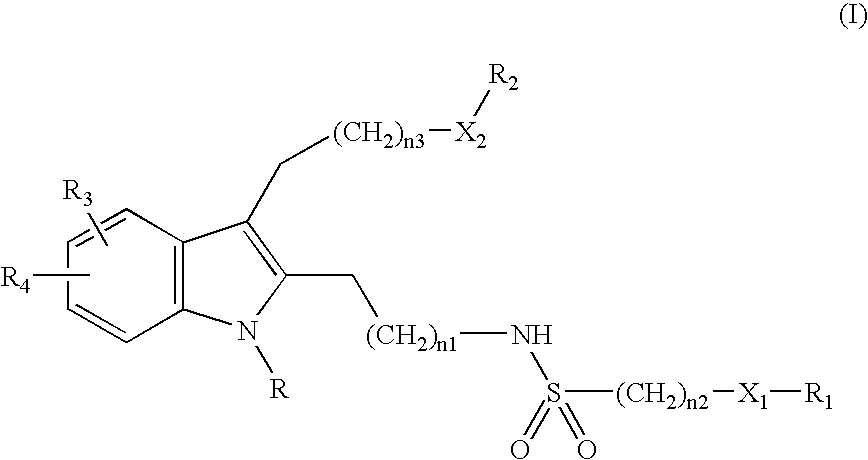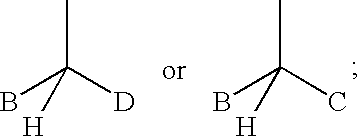Process for making an aldehyde
a technology of aldehyde and aldehyde, which is applied in the preparation of carbonyl compounds, organic chemistry, drug compositions, etc., can solve the problems that the hard reaction conditions are not suitable for all dihalogenated substances
- Summary
- Abstract
- Description
- Claims
- Application Information
AI Technical Summary
Benefits of technology
Problems solved by technology
Method used
Image
Examples
example 1
4-[2-(1-Benzhydryl-2-{2-[(benzylsulfonyl)amino]ethyl}-5-chloro-1H-indol-3-yl)ethoxy]benzoic acid
[0106]This synthesis is depicted in Method A.
[0107]Step 1: To 4-hydroxy-benzoic acid methyl ester (1.0 eq) in DMF (0.83 M) was added K2CO3 (2.0 eq) followed by 2-bromo-1,1-diethoxy-ethane and the reaction mixture was stirred at 110° C. for 2 days. TLC showed a new spot. The reaction mixture was diluted with ethyl acetate, washed with 1N NaOH, water, and brine, dried over sodium sulfate, and solvent was removed to afford desired product in 84% yield. This material was used in the next step without further purification.
[0108]Step 2: To the above product (1.0 eq) and 5-chloro-2-methyl indole (1.0 eq) in CH2Cl2 (0.12 M) was added triethylsilane (3.0 eq) followed by trifluoroacetic acid (3.0 eq). After being stirred overnight at room temperature, added water and trifluroacetic acid (1.0 eq) to the reaction mixture, stirred at room temperature for two days, diluted with CH2Cl2, washed with 1N N...
example 2
4-[2-(1-Benzhydryl-5-chloro-2-{2-[(isopropylsulfonyl)-amino]ethyl}-1H-indol-3-yl) thoxy]benzoic acid
[0115]Step 1: This compound was prepared from methyl 4-{2-[2-(2-aminoethyl)-1-benzhydryl-5-chloro-1H-indol-3-yl]ethoxy}benzoate (Step 6, Example 1) and isopropylsulfonyl chloride according to the procedure in Example 1 Step 7 in 55% yield.
[0116]Step 2: The ester intermediate was hydrolyzed according to Step 8 Example 1 to afford the title acid in 81% yield. HRMS calc for [C35H.35ClN2O5.S+H] 631.2028 found 631.2029.
example 3
4-[2-(1-Benzhydryl-2-{2-[(butylsulfonyl)amino]ethyl}-5-chloro-1H-indol-3-yl)ethoxy]benzoic acid
[0117]Step 1: This compound was prepared from methyl 4-{2-[2-(2-aminoethyl)-1-benzhydryl-5-chloro-1H-indol-3-yl]ethoxy}benzoate (Step 6, Example 1) and 1-butanesulfonyl chloride according to the procedure in Example 1 Step 7 in 61% yield.
[0118]Step 2: The ester intermediate was hydrolyzed according to Step 8 Example 1 to afford the title acid in 90% yield. HRMS calc for [C36H.37ClN2O5.S+H] 645.2185 found 645.2185.
PUM
| Property | Measurement | Unit |
|---|---|---|
| temperature | aaaaa | aaaaa |
| temperature | aaaaa | aaaaa |
| temperatures | aaaaa | aaaaa |
Abstract
Description
Claims
Application Information
 Login to View More
Login to View More - R&D
- Intellectual Property
- Life Sciences
- Materials
- Tech Scout
- Unparalleled Data Quality
- Higher Quality Content
- 60% Fewer Hallucinations
Browse by: Latest US Patents, China's latest patents, Technical Efficacy Thesaurus, Application Domain, Technology Topic, Popular Technical Reports.
© 2025 PatSnap. All rights reserved.Legal|Privacy policy|Modern Slavery Act Transparency Statement|Sitemap|About US| Contact US: help@patsnap.com



